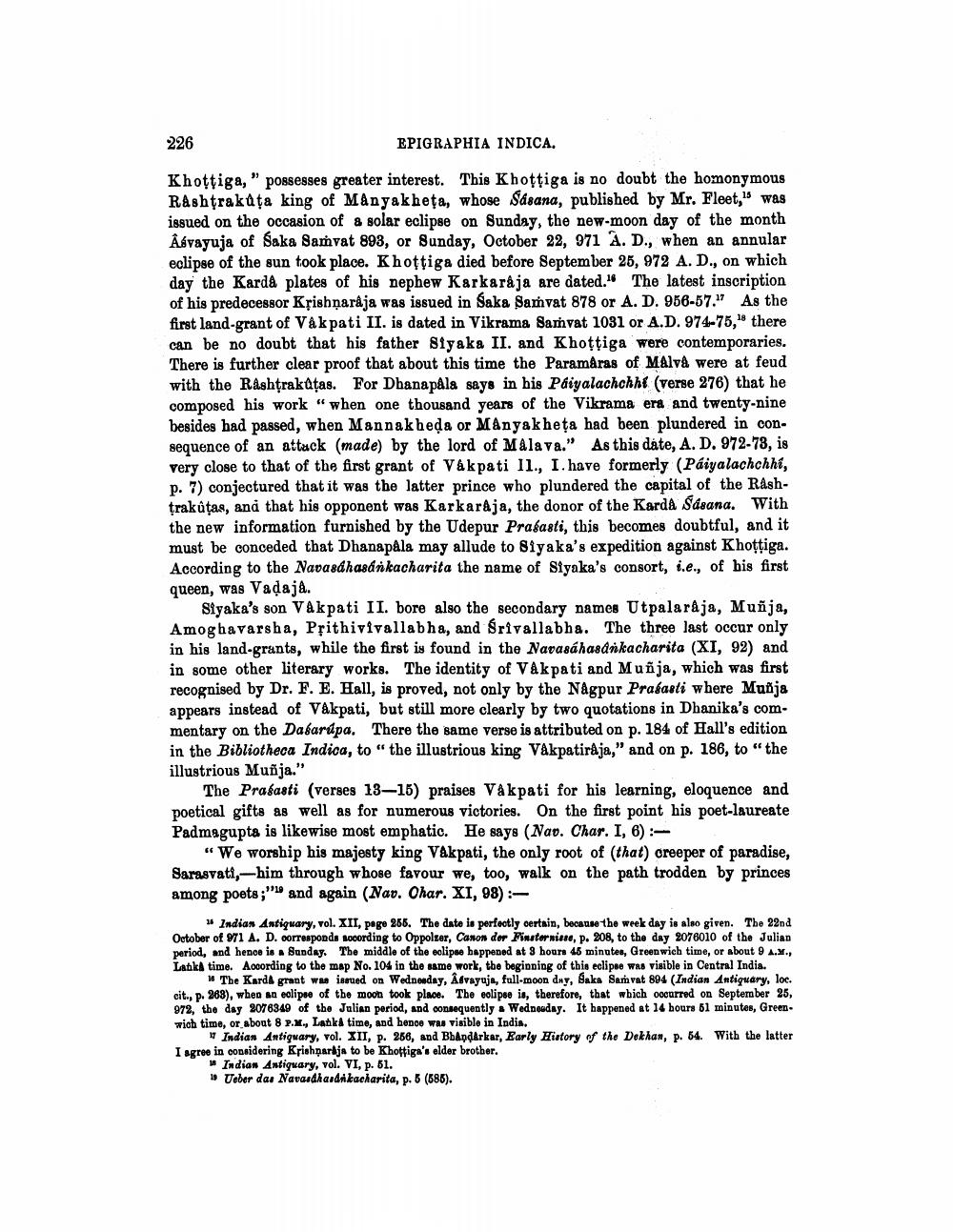________________
226
EPIGRAPHIA INDICA.
Khottiga," possesses greater interest. This Khoţțiga is no doubt the homonymous Rashtrakuta king of Manyakheta, whose Sasana, published by Mr. Fleet, was issued on the occasion of a solar eclipse on Sunday, the new-moon day of the month Âbvayuja of Saka Samvat 893, or Sunday, October 22, 971 A. D., when an annular eclipse of the sun took place. Khoţtiga died before September 25, 972 A. D., on which day the Karda plates of his nephew Karkaraja are dated." The latest inscription of his predecessor Křishnaraja was issued in Saka Samvat 878 or A. D. 956-57. As the first land-grant of VÅk pati II. is dated in Vikrama Samvat 1031 or A.D. 974-75," there can be no doubt that his father siyaka II. and Khoțţiga were contemporaries. There is further clear proof that about this time the Paramaras of Malvå were at feud with the Rashtrakațas. For Dhanapala says in his Paiyalachchht (verse 276) that he composed his work "when one thousand years of the Vikrama era and twenty-nine besides had passed, when Mannakheda or Manyakheta had been plundered in consequence of an attack (made) by the lord of Malava." As this date, A. D. 972-73, is very close to that of the first grant of Vakpati Il., I. have formerly (Páiyalachchhi, p. 7) conjectured that it was the latter prince who plundered the capital of the Rashtrakūtas, and that his opponent was Karkaråja, the donor of the Karda Śásana. With the new information furnished by the Udepur Prasasti, this becomes doubtful, and it must be conceded that Dhanapala may allude to Siyaka's expedition against Khottiga. According to the Navasdhasdn kacharita the name of Siyaka's consort, i.e., of his first queen, was Vadaja.
Siyaka's son Vakpati II. bore also the secondary names Utpalaraja, Muñja, Amoghavarsha, Prithivivallabha, and Srivallabha. The three last occur only in his land-grants, while the first is found in the Navasáhasánkacharita (XI, 92) and in some other literary works. The identity of Vakpati and Muñja, which was first recognised by Dr. F. E. Hall, is proved, not only by the Nagpur Prasasti where Muñja appears instead of Vakpati, but still more clearly by two quotations in Dhanika's commentary on the Dabardpa. There the same verse is attributed on p. 184 of Hall's edition in the Bibliotheca Indica, to "the illustrious king Våkpatirája," and on p. 186, to "the illustrious Muñja."
The Prasasti (verses 13-15) praises Våkpati for his learning, eloquence and poetical gifts as well as for numerous victories. On the first point his poet-laureate Padmagupta is likewise most emphatic. He says (Nav. Char. I, 6) :
“We worship his majesty king VAkpati, the only root of (that) creeper of paradise, Sarasvati,-him through whose favour we, too, walk on the path trodden by princes among poets ;" and again (Nav. Ohar. XI, 98) -
* Indias Antiquary, vol. XII, page 256. The date is perfectly certain, because the week day is also given. The 22nd October of 971 A. D. corresponde socording to Oppolzer, Canon der Finsterniane, p. 208, to the day 2076010 of the Julian period, and hence is a Sunday. The middle of the eclipse happened at 8 hours 45 minutes, Greenwich time, or about 9 .x., Lanks time. According to the map No. 104 in the same work, the beginning of this eclipse was visible in Central India.
* The Karda grant was inued on Wednesday, Afvayają, fall-moon day, saka Sarvat 894 (Indian Antiquary, loc. cit., p. 268), when an eclipse of the moon took place. The eolipse is, therefore, that which courred on September 25, 972, the day 2076349 of the Julian period, and consequently a Wednesday. It happened at 14 hours 51 minutes, Greenwich time, or about 8 P.X., Latka time, and hence was visible in India.
Indian Antiquary, vol. XII, p. 266, and Bhandarkar, Early History of the Dekhan, p. 54. With the latter I agree in considering Krishnarja to be Khoftiga's elder brother.
* Indian Antiquary, vol. VI, p. 61. * Ueber das Navardhandikacharita, p. 8 (586).




